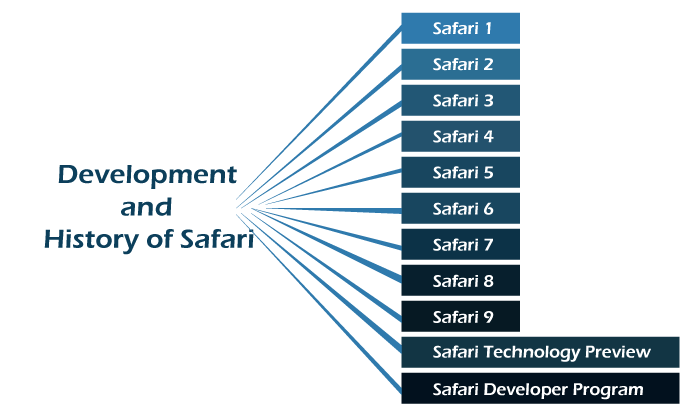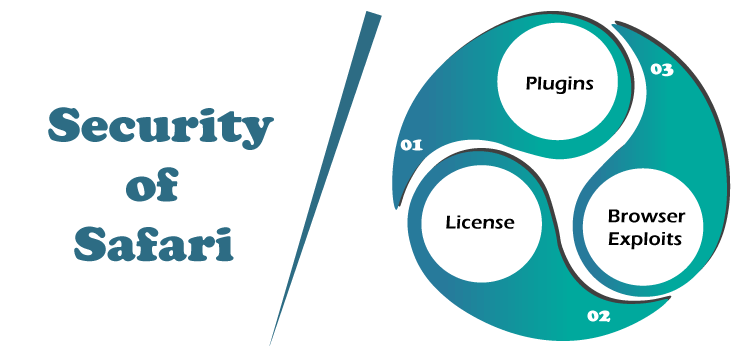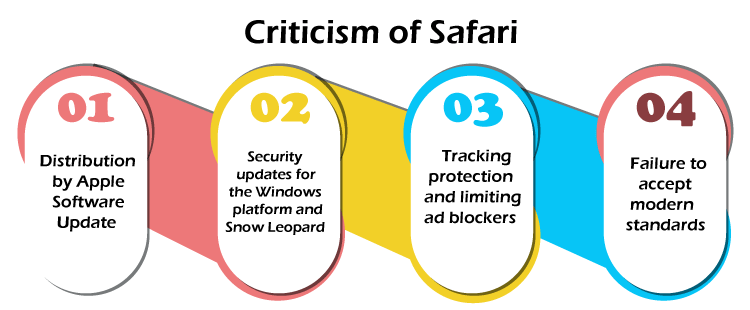Safari UbuntuIntroduction to SafariSafari web browser is graphical integrated by Apple. Primarily, it is based on open-source software and WebKit. It succeeded Internet Explorer, Cyberdog, and Netscape Navigator for Mac as a default web browser for Macintosh devices. It's supported on iOS, macOS, and iPadOS; a version of Windows was given from 2007 to 2012. In January 2003, Safari was published in Mac OS X Panther and has progressed from 15 major versions as of 2021. The third generation brought compatibility with iPhone OS 1 to the iPhone, while the Macintosh version was topped using the faster browser performance at that period. The 5th version published a lesser distracted page developer, reader, and extension tools; it was the final edition for Windows.
Apple utilized a remotely updated license of plug-in blacklist to prevent vulnerable or dangerous plugins from activating on Safari. Safari makes Mac OS X to be the first operating system to fall within a hacking competition in the Pwn2Own contest at the CanSecWest security conference 2008. It got criticism for its mechanism for software distribution and past restrictions of ad blockers. A Safari Developer Program was available for 99 US dollars per year which allowed members the right to integrate extensions for the browser. Safari became the 3rd most famous desktop browser after being overtaken via Edge in May 2022. Then, Safari was used by 9.61% of worldwide desktop computers. Development and History of SafariThe Macintosh computers of Apple were moved with the browser Cyberdog and Netscape Navigator before 1997. Later, it was substituted by Internet Explorer of Microsoft for Mac in Mac OS 8.1 upon the 5 years agreement among Microsoft and Apple. At this time, Microsoft disclosed three major Internet Explorer revisions for Mac which were utilized by Mac OS 9 and Mac OS 8, so Apple continued supporting Netscape Navigator as a replacement. Ultimately, Microsoft published a Mac OS X version of Internet Explorer in May 2020, which was arranged as the default browser in every Mac OS X version from Mac OS X DP4 to Mac OS X v10.2. Some others were joined, including the 'Freedom' title before the Safari name. Privately, it was called 'Alexander' for over a year, which specifies strings in coding styles; and 'iBrowse' before Safari was founded. 
Safari 1Steve Jobs (Apple CEO) disclosed Safari that was based on the internal KHTML rendering engine fork WebKit of the company at Macworld San Francisco on 7 January 2003. Apple published the first beta edition on Mac OS X. Later that time, many unofficial and official beta editions followed until the 1.0 version was published on 23 June 2003. Safari was pre-installed as the default browser of the system on Mac OS X version 10.3. Then, the predecessor of Safari (Internet Explorer for Mac) was added in 10.3 as a replacement. Safari 2Dave Hyatt Engineer fixed many errors in Safari in April 2005. His experimental beta acknowledged the Acid2 reading test on 27 April 2005, marking it the initial browser to do so. The 2.0 version of Safari, published on 29 April 2005, was the Mac OS X 10.4 sole browser given by default. Apple acknowledged this edition because it can run a 1.8x speed boost than the 1.2.4 version, but it didn't yet offer the Acid2 bug fixes. These big modifications were initially not available for end users until they installed the WebKit source code or executed one of the automated builds present at OpenDarwin. The 2.0.2 version, published on 31 October 2005, finally added the Acid2 bug fixes. Apple moved the bug tracking and development source code of JavaScriptCore and WebCore to OpenDarwin in June 2005 in KHTML efforts criticisms over the insufficient access to change logs. Also, they have open-sourced WebKit. This source code is for non-renderer features of the browser, like its GUI components and another proprietary. Safari 3Jobs disclosed that Safari was moved to the newly-introduced iPhone in iPhone OS at Macworld San Francisco on 9 January 2007. The mobile edition can display the desktop-class and full websites. Jobs unveiled Safari 3 for Windows Vista, Windows XP, and Mac OS X 10.5 at WWDC 2007. He ran a standard based on the iBench browser test suite than the most famous Windows browser to browser and requested that Safari have the best performance. His request was later determined by a third-party site known as Web Performance on HTTP load Times. Then, they authenticated that Safari 3 was the fastest browser in the Windows environments in the concept of initial data loading on the Internet. So, it was just slightly faster than Mozilla Firefox and Internet Explorer 7 when it came to fixed content through the local cache.
Safari 3.2, published on 13 November 2008, represented anti-phishing aspects using the Extended Validation Certificate and Google Safe Browsing support. The final Safari 3 version was 3.2.3, which was published on 12 May 2009 with security improvements. Safari 4Safari 4 was published on 11 June 2008. It was the first release that had fully passed the Acid3 rendering test. It consolidated the WebKit JavaScript engine SquirrelFish that mainly enhanced the script interpretation performances of the browser by 29.9x. Later, SquirrelFish was derived into SquirrelFish Extreme, later advertised as Nitro, which had 63.6x faster performance. A public Safari 4 beta was experimented on 24 February 2009. Safari 4 was dependent on Cover Flow to execute the Bookmarks and History, and it offered speculative loading that pre-load document details automatically that are needed to visit a specific website. The top sites can be shown in up to 24 thumbnails based on the visited sites in any startup.
The 4.0.1 version of Safari was published on 17 June 2009 for Mac and resolved Faces bugs in iPhoto '09. In Mac OS X 10.6 version (Snow Leopard), Safari 4 has 64-bit built-in support, which enables JavaScript to load up to 50% faster. Also, it has native crash resistances that keep it intact when a plug-in, such as Flash Player crashes, so other windows and tabs will not be affected. The final version is Safari 4.0.4, which was published on 11 November 2009 for both Windows and Mac, which further integrated the JavaScript performances. Safari 5Safari 5 was published on 7 June 2010 and was the final version for Windows. It offered a screen reader and had 30x faster performances of JavaScript. It consolidated numerous developer tool integrations, including accessibility to safe extensions and HTML5 interoperability. The progress bar was also re-added in this release. The 5.0.1 version of Safari, by default, activated the Extensions PrefPane, instead of needing users to set it manually within the Debug menu. Safari 6Previously, Safari 6.0 was referred to as the 5.2 version of Safari until Apple modified the number of the version at WWDC 2012. The same version of Safari 6 coincided with the version of OS X Mountain Lion on 25 July 2012 and was developed within OS. As an outcome, it was no longer present for download from the website of Apple or any other sources. Apple published Safari 6 by Software Update for OS X Lion users. It was not published for OS X releases before Windows or Lion. Later, the company quietly removed links and references for the Windows release of Safari 5. Also, Microsoft deleted safari through its browser-choice page. Safari 7At WWDC 2013, Safari was disclosed, and it brought a JavaScript performance improvement number. It made use of Sidebar and Top Site, Power Saver, and Shared Links, which paused unutilized plugins. The 7 version of Safari for OS X Mavericks and the 6.1 version of Safari for Lion and Mountain Lion were published with OS X Mavericks in the unique event on 22 October 2013. Safari 8At WWDC 2014, Safari 8 was disclosed and published in OS X Yosemite. It was composed of the JavaScript engine WebGL, powerful privacy management, a developed iCloud integration, and a re-structured interface. Also, it was more efficient and faster with extra development markups, including 3D and 2D interactive JavaScript API WebGL, CSS Shapes & Compositing markup, JavaScript Promises, SPDY protocol, Encrypted Media Extensions, and IndexedDB. Safari 9In WWDC 2015, Safari 9 was disclosed and published in OS X EI Capitan. New aspects include improved autofill, several options for Safari reader, and audio muting. It was not completely available for the early OS X Yosemite because Apple needed it to be updated to Capitan. Safari 10It was published within OS X EI Capitan and OS X Yosemite on 20 September 2016. It had re-structured History and Bookmarks views, and double-clicking will focus on a specific folder. Safari Technology PreviewFirst, it was published alongside the 10.11.4 version of OS X EI Capitan. Safari Technology Preview published includes the latest release of WebKit, which added Web technologies in the further stable versions of Safari so that users and developers can install it on a Mac, check those features, and give feedback. Safari Developer ProgramIt was a program embedded in HTML and in-browse extension developers. It permitted members for writing and distribution extensions for a browser from the Safari Extensions Gallery. In WWDC 2015, it was free until it was consolidated into the Apple Developer Program, which costs 99 dollars a year. These charges promoted annoyance from developers. Apple supplied the Secure Extensions Distribution to enhance its security in OS X EI Capitan and updated every extension in the Safari Extensions Gallery automatically. Security of Safari
PluginsApple utilized a remotely updated plug-in blacklist to potentially prevent vulnerable or dangerous plugins from activating on Safari. Java and Flash contents were initially blocked on a few early releases of Safari. Since the 12 version of Safari, which supports NPAPI plugins, has been fully dropped. Beginning with the Safari 14 release, Adobe Flash Player support will be dropped. Browser exploitsSafari enabled Mac OS X to be the initial operating system to fall in any hacking competition at the CanSecWest security conference 2008 in the Pwn2Own contest in Vancouver. Participants competed to look for a way for reading the contents of a file placed on the desktop of the user in one of three OSes: Ubuntu 7.10, Windows Vista SP1, and Mac OS X leopard. Fraud detection and browser fingerprinting service FingerprintJS detected a vulnerability within the IndexDB API implementation utilized by Safari 15 on iPadOS, iOS, and macOS in WebKit storage, in January 2022. This vulnerability permits a malicious site for accessing browsing activity and history as well as user personal session data on another website, which is an infringement of the same-origin policy. This vulnerability was patched through Apple and assigned CVE-2022-22594. The fix was published alongside macOS 12.2 and iOS 15.3 on 26 January 2022. LicenseThe license has basic terms of reverse engineering, sub-licensing and copying, open-source except parts, liability and its warranties. The permission to prefer the tracking was restricted to particular devices. Apple introduced "personal" thatdoesn't cover "unique device identifiers" like IP address, cookie number, or serial number, so the utilization of these was allowed by law. Apple disclosed that it would utilize Artificial Intelligence for reducing the capability of advertisers to record Safari users when they browsed the Internet in September 2017. Cookies will be permitted for 24 hours, then deactivated for tracking unless artificial intelligence judges the user wishes the cookies. System requirements and other featuresSafari is also a Cocoa application on macOS. It used the WebKit of Apple to render web pages and run JavaScript. WebKit is composed of WebCore and JavaScriptCore. Like KJS and KHTML, JavaScriptCore and WebCore were free software and published upon the GNU Lesser General Public License terms. A few Apple improvements to the code of the KHTML were added to the Konqueror project. Also, Apple had published a few extra codes upon the open-source 2clause BSD-like license. The Safari version added in Mac OS X 10.6 version is compiled for 64-bit architecture. Until the 6.0 of Safari, it added a built-in feed aggregator that supports the Atom and RSS standards. Current aspects included private browsing, the ability for archiving web content within the WebArchive format, the capability to email full web pages from a browser menu directly, the capability for searching bookmarks, and the capability to distribute tabs between every iOS and Mac device running correct software versions by an iCloud account. Apple published WebKit2 in April 2010. For OS X, Safari switched to the fresh API with the 5.1 version. For iOS, Safari switched to WebKit2 along with iOS 8. Criticism of Safari
Distribution by Apple Software UpdateAn early release of Apple Software Update (arranged with iTunes, QuickTime, and Safari for Microsoft Windows) chose Safari for installation from an Apple program list to by default download, even when it didn't recognize an existing Safari installation on the user's machine. Former Mozilla CEO, John Lily, said that the use of Apple of its updating software for promoting its other commodities was "a bad practice and should stop". Bill Evans, the Apple spokesman, stated back to the statement of Lily, stating that Apple was just "using Software Update for making it convenient and easy for both Windows and Mac users to bring the latest Safari update through Apple". Also, Apple published a new Apple Software Update version that puts fresh software in its section, though still by default chosen for installation. By late 2008, Apple Software Update is not chosen new installation items by default in the new software section. Security updates for the Windows platform and Snow LeopardSophos, a software security firm, explained how Windows and Snow Leopard users were not supported by the 6 version of Safari, while there were 121+ vulnerabilities left unpatched on the platforms. Snow Leopard has had three negligible version releases, and Windows has had only one. The implication is that there are the final releases available for these OSes, and both contain significant security problems. Tracking protection and limiting ad blockersApple made technical modifications to the content blocking functionality of Safari, which promoted backlash from developers and users of ad blocking extensions beginning in 2018, who said the modifications made it impossible to provide the same user protection level detected in other browsers. The update internally restricted the blocking rules, which could be used by third-party extensions and prevented the complete implementation of community-developed blocklists. In reply, many developers of famous tracking and ad blockers disclosed their products that were being discontinued, because they were now unsuitable with the newly restricted content blocking features of Safari. Apple needs WebKit usage, as a policy matter, the underlying rendering engine of Safari, as the rendering engine for every browser integrated into its iOS environment, preventing users from having any competing product which provides complete ad blocking functionality. Famous extensions, such as uBlock Origin, are not working with Safari starting with Safari 13. Failure to accept modern standardsNow, while Safari developed many standard features of HTML5 (like the Canvas API) in previous years, it has come upon attack to fall to retain pace with a few modern web technologies. iOS has permitted the web browsers of a third party to be installed since 2015, including Edge, Opera, Firefox, and Chrome; however, they are forced to apply the underlying WebKit browser engine and acquire its limitations.
Next TopicUbuntu Dock
|
 For Videos Join Our Youtube Channel: Join Now
For Videos Join Our Youtube Channel: Join Now
Feedback
- Send your Feedback to [email protected]
Help Others, Please Share










